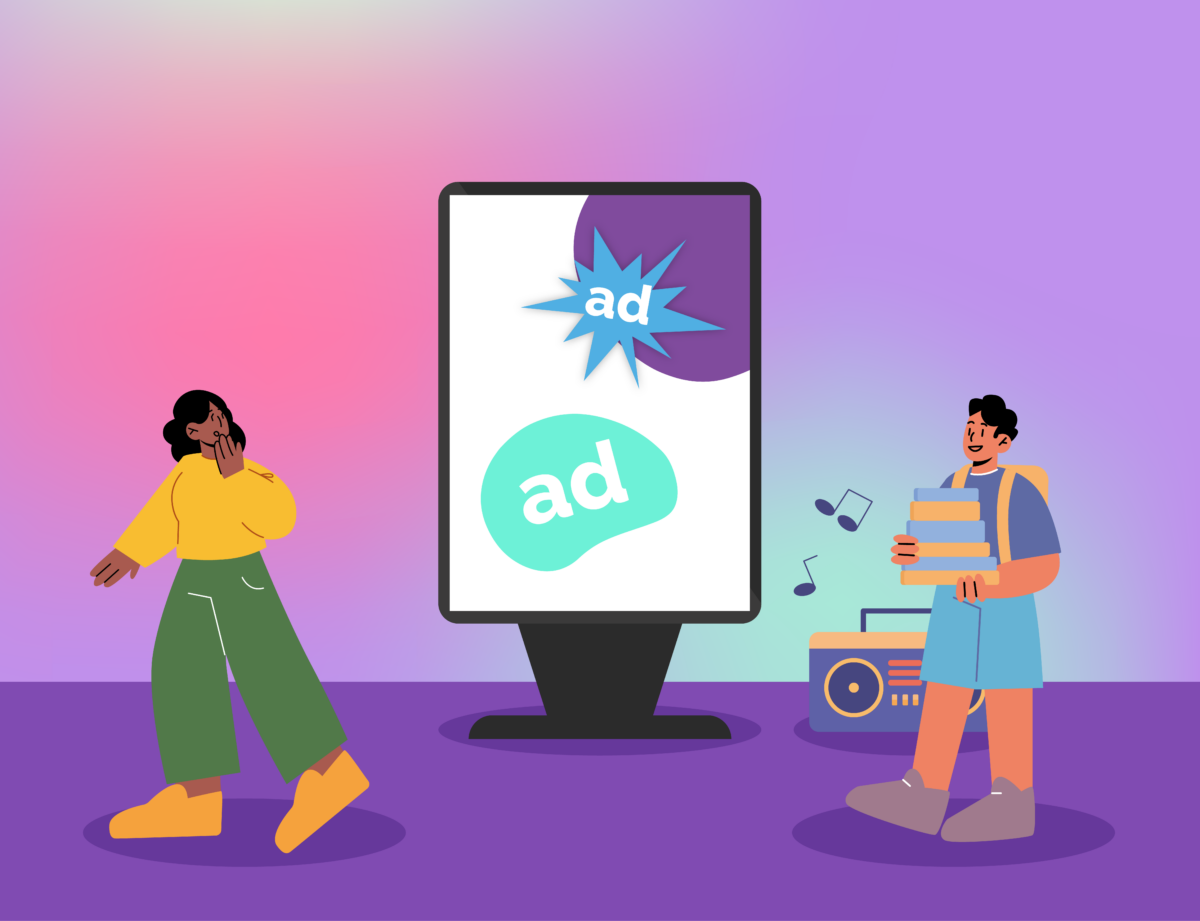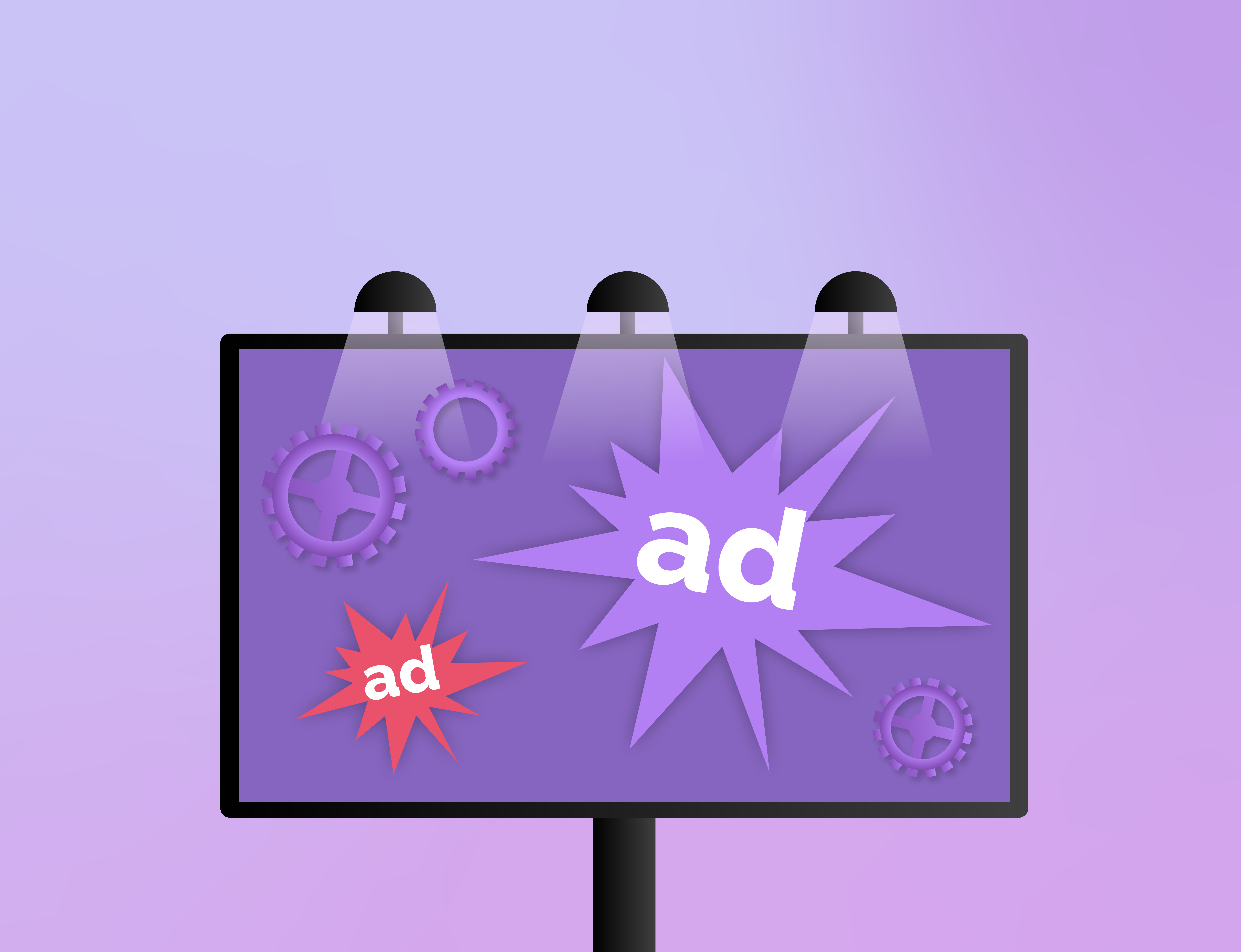Programmatic digital out-of-home (pDOOH) continues to be a game-changer in the DOOH space, redefining how brands use outdoor advertising to connect with their target audience. But what exactly sets pDOOH apart from traditional digital out-of-home advertising, and how is it beneficial to your business?
In this article, we’ll be going through what pDOOH actually is and the best ways you can implement it in your advertising strategy.
What Is Digital Out-Of-Home Advertising?
Digital out-of-home advertising uses digital screens to deliver visually captivating advertisements in public spaces. It was one of the fastest-growing media sectors of 2022, and a 2023 survey among global marketers found that almost 60% of these professionals associated digital outdoor advertisements with accurate audience targeting, brand safety, and awareness.
Digital out of home advertising is generally found in high-traffic areas on billboards, LED screens and digital signage. This allows brands to be highly visible with graphics and videos within advertisements, as opposed to a more traditional static image on a billboard.
What is Programmatic Digital Out-Of-Home (pDOOH) Advertising?
Programmating digital out-of-home (pDOOH) refers to the automated process of buying the ad space in real time. Now, 28% of US advertisers work exclusively with programmatic DOOH campaigns—although, a further 32% combine programmatic buying with manual ad buying.
While DOOH has been a powerful medium for brand exposure and engagement, pDOOH goes a step further, leveraging the automation capabilities of programmatic technology to optimize ad placement and content delivery.
Doing this offers your business several benefits:
- Greater efficiency: Programmatic digital OOH automates the ad buying and selling process, which saves time and money. You can use programmatic platforms to set budgets, target specific audiences, and track performance in real time.
- More precise and personalized targeting: Programmatic DOOH allows you to target ad campaigns at specific demographics, interests, and even locations. This enables the delivery of highly relevant and personalized ads to specific demographics who are most likely to be interested in them. Plus, you can integrate first-party data to target the right audiences at the right time.
- Increased flexibility: Programmatic DOOH provides more flexibility in running campaigns. You can change your budgets, targeting, and creatives on the fly, allowing you to respond quickly to market or business changes.
- Improved measurement: Programmatic DOOH provides better measurement and reporting capabilities. You can track real-time metrics, such as impressions, reach, frequency, and conversions to improve campaign optimization and results.
One of the crucial aspects of a programmatic DOOH campaign are the different types of screens that bring these campaigns to life. However, before exploring the various screens used in pDOOH, you need to understand the formats and venues where you can apply programmatic DOOH ads.
Programmatic DOOH Ad Formats
The main types of programmatic DOOH screens advertisers use are:
Large Format: Making Bold Statements
Large format ads are the most visible and attention-grabbing type of DOOH media types, and advertisers usually place them in high-traffic areas, such as highways, city centers, and sports stadiums. Due to their strategic locations (for example, Times Square), large format ads offer unparalleled visibility, so they are ideal for driving brand awareness and reach.
Place-Based: For A More Tailored Consumer Experience
Place-based screens are placed in specific locations that are relevant to the target audience. In other words, rather than target the general public, place-based screens consider the contextual relevance of the location where they are placed.
For example, a clothing brand might place ads in a fashion retail shop, and a restaurant may place ads in office buildings where people are likely to want to eat at lunchtime. As a result, place-based ads can be more targeted than large format ads, and they can also be more effective at driving engagement.
Point of Purchase: Appealing to Consumers at the Point of Purchase
Point of purchase displays are placed at or near the point of sale, such as in grocery stores, pharmacies, and gas stations. They are ideal for facilitating last-minute purchasing decisions — for example, by promoting discounts or coupons — and can effectively drive immediate results.
The screen types used in programmatic DOOH will typically fall under these three format categories, but they will vary depending on the location and purpose of the campaign.
Screen Types Used in Programmatic DOOH Advertising
Here are the most common screen types used in programmatic DOOH advertising to reach and connect with audiences:
Digital Billboards
A good example of a large ad format, digital billboards are the captivating giants of the advertising world, which have seen significant growth in recent years. These high-resolution screens are strategically placed in high-traffic areas, such as highways, major roads, or bustling urban centers, capturing the attention of both motorists and pedestrians alike. Their dynamic and eye-catching advertisements are designed to leave a lasting impression.
Advertisers are able to leverage programmatic technology to target specific demographics and times of day, to boost sales at relevant times. For instance, they can display fast food ads during lunchtime or after work, or car ads during rush hour.
Top benefits of digital billboards
There are a number of benefits to using digital billboards.
- High visibility and reach: These digital displays have unparalleled visibility and reach, thanks to their strategic locations.
- Dynamic content: You can update content in real time, ensuring fresh and relevant ads.
- Precise targeting: Programmatic technology enables precise audience targeting.
Digital Mobile Billboards
Digital mobile billboards take advertising to the streets — literally. These billboards involve large LED screens mounted on vehicles like trucks, buses, or trailers, allowing you to advertise on the move.
Programmatic advertisers are able to take advantage of the versatility digital mobile billboards provide, using them for various advertising purposes. This can range from promoting products and services to raising awareness about events or campaigns.
Top benefits of digital mobile billboards
Similar to digital billboards, mobile billboards bring a range of benefits.
- High visibility: These billboards are easy to notice as they move through the urban landscape, targeting a wider range of high traffic areas.
- Targeted advertising: You can strategically plan routes and schedule ads for specific demographics or locations.
- Cost-effectiveness: Since they allow you to maximize your reach with a single mobile unit, digital mobile billboards offer a cost-effective alternative to traditional static billboards.
- Portability: Because these billboards are portable, you’re able to reach audiences that traditional billboards can’t reach. For example, you can park up in a large event or exhibition space that may not have traditional billboard space.
Digital Posters
Digital posters are smaller screens that commonly populate indoor places like malls, airports, train stations, and retail stores. They are great for capturing the attention of a captive audience and promoting products, services, or events.
When used in pDOOH advertising, digital posters can be programmed to display content based on location, time of day, or audience demographics, making them effective for targeted advertising.
Top benefits of digital posters
- Targeted advertising: You can reach a specific indoor audience effectively.
- High dwell time: People often spend time in indoor spaces, providing ample exposure to your message.
- Flexibility: You can update content quickly, ensuring relevance
Video Walls
A video wall is a large display that is made up of multiple individual screens. The screens are typically arranged in a grid or other pattern and synchronized to display a single image or video. Video walls are used in shopping malls, conference centers, and corporate lobbies to display dynamic content, advertisements, and information.
Advertisers can use programmatic DOOH advertising to program video walls to showcase a variety of content, such as product promotions and event schedules.
Top benefits of video walls
- High impact: The large display size of video walls creates a powerful visual presence.
- Versatility: You can display various types of content.
- Ideal for high foot traffic areas: Video walls are perfect for indoor spaces with bustling activity.
Digital Street Furniture Screens
Digital street furniture screens seamlessly integrate into urban infrastructure, such as bus shelters, newsstands, benches, and kiosks to engage pedestrians in high-traffic areas.
In programmatic DOOH, street furniture screens are ideal for brand awareness and can display local business promotions, event information, or public service announcements.
Top benefits of digital screen furniture screens:
- Targeted reach: You can target specific demographics, interests, or locations with the screens.
- Cost-effective: The screens are easily scalable based on campaign goals and budget.
- Complement other ad formats: They work well with other ad formats, including billboards.
Interactive Screens
Interactive screens invite users to engage with content through touch, gesture, or mobile device interactions. You can often find them in malls, rideshares, museums, and other public spaces.
Advertisers can create immersive and interactive brand experiences, such as virtual try-ons, games, or product exploration.
Top benefits of interactive screens:
- High engagement and interactivity: Users can actively engage with the content.
- Data collection: Interactive screens allow for personalized advertising based on user interactions.
- Enhanced user experiences: The screens offer a unique and memorable experience.
Transit Displays
Transit displays are installed in public transportation vehicles and transit stations, giving advertisers a captive audience during commutes. These can also be implemented in rideshare apps, like Uber, allowing brands to target clients based on their current journey. For example, targeting specific holiday deals when a rider is on the way to the airport.
Advertisers can use programmatic technology to display contextually relevant ads, such as promoting local businesses or events.
Top benefits of transit displays:
- Captive audience: Commuters have limited distractions during transit.
- Large audience reach: Millions of people see transit displays daily, making them an ideal way to reach a large audience, especially in urban areas.
- Geo-targeting: You can deliver location-specific ads.
- Ride-sharers: Advertisers can deliver specific ads based on where their audience is traveling to while they’re in the cab.
3D Billboards
Show-stopping 3D billboards are wholly impressive and can have pedestrians stop walking to marvel at an advertisement on the street. These anamorphic designs capture attention and create a more immersive experience for passers by. However, they require much more input, and typically cost more to create and run than a traditional 2D advertisement.
Using programmatic DOOH buying, marketers are able to choose exactly when to show these adverts in order to get the biggest return on investment.
Benefits of 3D billboards
- Create a lasting impression: 3D adverts are more likely to draw attention than a standard 2D design, creating a lasting impression and driving brand awareness.
- Drive authority: Businesses that invest in 3D advertisements are more likely to be classed as a prestigious brand by the consumers, driving brand authority.
- Create campaign virality: DOOH 3D billboards can bring the ‘wow’ factor to your advertising campaign, making users stop and film your advert and share it online, which can promote virality.
Getting Your pDOOH Advertising Strategy Right with Grapeseed
Programmatic DOOH advertising offers unprecedented opportunities for brands to engage their audiences in innovative and targeted ways. Whether through towering digital billboards, captivating mobile displays, or immersive interactive screens, the possibilities are limitless.
However, unlocking the full potential of pDOOH requires a strategy that seamlessly blends programmatic technology with human expertise to fine-tune campaigns. While it’s possible to develop a strategy on your own, partnering with the seasoned experts at Grapeseed Media can simplify the process.
Grapeseed is your trusted partner in navigating the world of pDOOH advertising. We have the expertise and technology to help you create and execute a robust pDOOH strategy that delivers results. Get in touch with our team to discover more about programmatic DOOH and how we can help.





